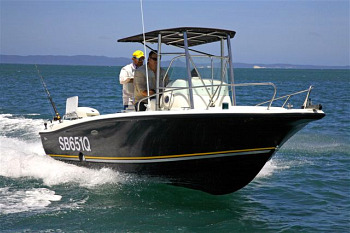Yamaha 300 Outboard Review

By negating the need for intrusive engine boxes and the kind of internal engineering that goes with mounting engines inboard, Yamaha has put a new set of options on the table about the stern configuration of boats that once were stuck with a choice between shafts and sterndrives.
The V8s also caused a stir among big trailerboats. That is, boats close to the biggest hulls that can be trailered by a decent vehicle, particularly fishing boats that have traditionally been fitted with outboards because mounting the engine inboard restricted cockpit space severely.
Boats like CruiseCraft’s Explorer and Outsider 685 (about as fine a pair of offshore fishers as are built in this country) were set up for big outboards, and rated to a max of 270hp. How big a jump would it be to mount one of the new 300s on the back?
Quite a jump, actually, as we found out while testing an Explorer 685 with a new Yamaha F300 AETX/09 on its transom.
A couple of years ago, Modern Fishing tested a pair of Explorer 685s—one powered by a single 225hp Yamaha four-stroke and the second with a pair of 135hp supercharged Mercury Verados.
It was a fascinating day and if at the end of it you had asked me which boat I preferred, I couldn’t have told you. It was the security of a twin installation versus the fuel efficiency and lower cost of a single outboard.
So why a 300hp engine at all? Good question. We got lucky, in that we had CruiseCraft’s Kevin Nichols along for the day. Kev’s the patriarch of the Brisbane-based marque, and a man who knows trailerboats as few others do. He’s also known for his honest opinions about boats. I asked Kevin what was involved in uprating the 685 hull for the newer, more powerful outboards. I wasn’t surprised to learn that CruiseCraft put itself through an exhaustive process.
I guess you don’t become as popular as CruiseCraft is by simply changing a VIN plate to uprate a hull. To satisfy its own standards and to comply with the international CE certification CruiseCraft boats are constructed to, it had to revisit and re-engineer the entire hull design.
By the time every detail had been taken care of, it had been a hell of a process. Which is why only CruiseCraft 685 hulls built to the new rating can be powered up to the new 300hp maximum.
Interestingly, CruiseCraft ensured the new 300hp rating included twin installations. So that means even twin Verado 150s—which are far from a lightweight combo—can be hung from the aft end.
With the formalities out of the way, we departed Manly Harbour looking for some open water to let our test Explorer 685 and 300 Yammie stretch their legs. I couldn’t help but notice Kev fiddling with an array of buttons around an impressive Furuno screen on the 685 Explorer’s dash panel.
“Check this out,” he grinned. Kev overlaid maps of Moreton Island and Moreton Bay with Google Earth-type aerial images, then showed me the underwater maps available for the area offshore.
I had to ask the obvious question of course: how much does it cost? About the same as my entire boat, truth be told.
The Explorer 685 with twin 135 Verados I tested two years ago boogied. As you’d expect, this one boogied even more! Surprisingly, the top speed only increased from 39.7 knots to near 45.5. That’s getting close to 85km/h with the trim wound out to reduce drag, a big white rooster-tail shooting 50m behind us and fuel pumping through at an alarming 107.8 litres per hour.
Interim acceleration was just awesome, especially at 5000rpm. At those revs we were moving along at 38 knots and if the throttle was pushed to the limit the big Yammie still delivered an arm-yanking boot in the backside.
We had a couple of technical types from Yamaha along to help out with driving camera boats, and there was a rep from Furuno, too. He’d brought along some poor unsuspecting Frenchman from the company.
He was blown away by the combo we were testing, to the point it was obvious they don’t make boats like this in Europe!
This made the day heaps of fun for known hoons like yours truly, but somewhere along the line I needed to come back to earth and ask what relevance, if any, this has to people who fish? And why might anglers consider powering one of the best offshore fishing boats in the country with a 5.3-litre, V8, 300hp outboard. For comparison’s sake, V8 supercars only use five-litre motors.
The figures explaining the “why?” are evident at around a 3500rpm cruise. At these mid-range revs, the big V8 was in its element, pushing the CruiseCraft at 26 knots and only using 37 litres of fuel per hour. Easing back to 3000rpm, we were still covering water at 20 knots and using less than 30 litres per hour.
For each litre of fuel used between 3000 and 3500rpm, the Explorer 685 was covering 0.7 nautical miles.
Opening the taps up to 4000rpm increased our speed across the water to more than 30 knots while we were covering 0.66 nautical miles per litre.
In terms of the ratio of fuel used to ground covered, this means a CruiseCraft Explorer 685 powered by a Yamaha F300 has a very long set of legs indeed.
Translate this to fishing spots like Hervey Bay and the Barrier Reef, and those long legs become an attractive proposition.


